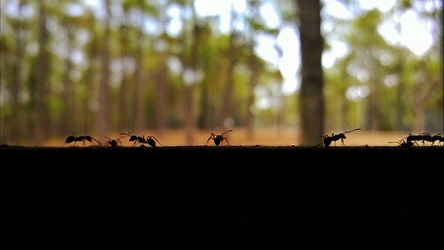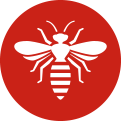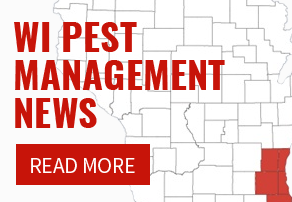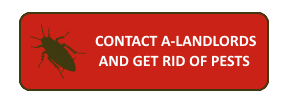Milwaukee Ant Control: Identifying and Eradicating Carpenter Ants
We get many calls from homeowners worried about carpenter ants ruining their decks or wood siding. If you’ve ever punched through a chewed-up piece of decking with a screwdriver and found thousands of little white eggs and a swarm of ants frantically crawling around, you’ve probably met the carpenter ant. So, how serious is this problem?
Identifying Carpenter Ant Infestations in Your Milwaukee Home
Carpenter ants (Camponotus spp.) are medium to large ants, all black or black and red. Worker ants range from 3/8” to ½“ in length, with queens typically reaching 1”.  Carpenter ants typically nest in moist wood outdoors, such as fallen trees, piles of firewood or the decks of homes. A large colony of carpenter ants can number in the thousands. Carpenter ants will forage as far as 100 yards in search of food. The worker ants of the colony are most active at night, traveling from their nest to a food source along trails they have established by releasing pheromones. It is during these foraging forays when ants can and do enter homes, often nesting in the moist wood behind shower tiles, under kitchen sinks, in window or door frames, and in other locations susceptible to water damage. Once inside a house, the typical kitchen’s remnants of sugar, honey, jellies, meats and fats of all kinds provide an endless buffet.
Carpenter ants typically nest in moist wood outdoors, such as fallen trees, piles of firewood or the decks of homes. A large colony of carpenter ants can number in the thousands. Carpenter ants will forage as far as 100 yards in search of food. The worker ants of the colony are most active at night, traveling from their nest to a food source along trails they have established by releasing pheromones. It is during these foraging forays when ants can and do enter homes, often nesting in the moist wood behind shower tiles, under kitchen sinks, in window or door frames, and in other locations susceptible to water damage. Once inside a house, the typical kitchen’s remnants of sugar, honey, jellies, meats and fats of all kinds provide an endless buffet.
Carpenter Ants: Nuisance or Nemesis?
When Carpenter ants get inside a home, their calling card is a small pile of “frass”--coarse, sawdust-like wood particles mixed with fragments of insects (a staple of the carpenter ant’s diet!). Understandably, many homeowners think Carpenter ants eat wood. Actually, however, they excavate small tunnels in soft wood (and foam insulation). These are smooth, clean excavations with the appearance of having been sanded down. In most cases, any wood carpenter ants infiltrate is already so damaged by moisture it is in need of replacement. In the rare instances when carpenter ants burrow into good wood, the damage is usually fairly minor and limited to a relatively small area.
Although Carpenter ants do not pose as great a threat as termites, an infestation of these ants is not something you want to just live with. A colony of Carpenter ants will grow quickly, particularly due to the abundance of food sources in a home. By the time any signs of infestation are visible—such as small piles of sawdust—there may already be extensive structural damage. If they’re nesting in support beams or in decking, you obviously want to get rid of the ants and replace the damaged wood as quickly as possible. Also, if you have small children or pets in your home, you should be aware that Carpenter ants can and do bite. Their sharp bites inject formic acid under the skin which causes further irritation.
Milwaukee Ant Exterminator Eliminating Carpenter Ants
The key to eliminating carpenter ants inside your house is to find the nest and eliminate it. If you can eradicate the nest—and with it the queen—the colony cannot survive. Tracking down the nest is not usually difficult, but it can be time consuming. One trick is to wait until early evening and put out some food they like—sugar or honey works well. With a red filter over a flashlight (because they cannot see red), you can often track them back to their nest after they’ve filled up with sweets. If you spot winged Carpenter ants, there is nearly always a colony nearby. Sometimes, if the nest is large enough, you may be able to locate it by the crackling sounds these ants make. Often, however, the nest is in such a difficult to reach location it makes any DIY eradication impossible.
A-Landlords has extensive experience tracking down and eradicating Carpenter ant colonies. We use a variety of insecticides proven to have great success in eliminating the queen ant and hastening the demise of the entire colony. If you suspect you have Carpenter ants in your home, don’t put off taking action. Our Milwaukee pest control specialists will assess your situation and provide you with a quote. Call 414-449-8525 today to rid your home of Carpenter ant infestations.









 Bed Bug
Bed Bug Ant
Ant Roach
Roach Wasp
Wasp Spider
Spider Rodent
Rodent


